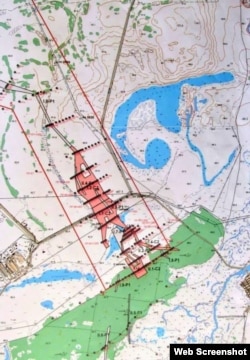On April 26, the world commemorates the Chernobyl accident, the deadliest nuclear disaster in human history that unfolded 38 years ago.
The USSR authorities concealed the catastrophe for days, causing radiation exposure for nearly 8.4 million people and thousands of deaths in what is now Ukraine, Belarus, and Russia, as well as irreparable damage to Europe’s environment.
Russia marks the Chernobyl anniversary as its atomic agency Rosatom faces accusations of covering up yet another nuclear incident involving the flooding of its uranium mills in Siberia.
In April, massive floods devastated dozens of Russian far-eastern regions. The city of Orsk in the Orenburg region suffered the most from the disaster after a dam on the Ural River broke on April 5.
By April 9, the flood reached the Kurgan region, including the village of Zverinogolovskoye, forcing the evacuation of its residents.
This village’s location near the Rosatom’s Dobrovolnoye uranium deposits and mills led to concerns about potential radioactive pollution of the Tobol River waters.
Rosatom repeatedly dismissed these fears as “Ukrainian propaganda and disinformation.”
On April 20, Rosatom stated that the Dobrovolnoye uranium deposit is not affected by the flood, because it, like other deposits in the Zverinogolovsky district of the Kurgan region, is located “far from the river, on a hill.”
Dinis Ezhurov, general director of the Dalur company, which is part of Rosatom's mining division, assured that the flood will not affect uranium production at the Dobrovolnoye deposit, because its production sites are “reliably protected.”
On April 23, Rosatom stated that uranium mills in the Kurgan region of Russia are located on a hill and have not been affected by the flooding.
“The fields of JSC Dalur are located on a hill and away from the water. The flood did not affect them. There is no threat of flooding.”
Rosatom later clarified to TASS, the Russian state-owned news agency that “[we] are talking about all wells, both spent and operating.”
These claims are likely false.
After analyzing satellite images of the flooded area, Russian and Western investigative journalists concluded that parts of Rosatom’s uranium mills have submerged and are covered with water.
Russian environmentalists warned that this could lead to the release of the radioactive solution into the Tobol River, which supplies fresh water to hundreds of thousands of residents in Russia’s Kurgan region, before flowing into the Arctic Ocean.
On April 23, investigative journalists at Agentstvo, a Russian independent news outlet in exile, reported that satellite images confirmed the flooding of part of the Dobrovolnoye uranium deposit in the Zverinogolovsky district.
Agentstvo compared the satellite images published by Mark Krutov, the editor of VOA’s sister organization Radio Free Europe/Radio Liberty (RFE/RL), and by Vadim Shumkov, the governor of the Kurgan region.
A comparison of Planet Labs's satellite images of the Zverinogolovsky district taken on April 20, 2024, and published by Krutov next to a map of the Dobrovolnoye uranium deposit shows that the territory of the deposit and wells was partially flooded.
Satellite images published on April 20 by Kurgan Governor Shumkov confirm the flood zone on the territory of the Dobrovolnoye deposit.
The Dalur company representatives demonstrated the map of the Dobrovolnoye uranium deposit during the public hearings in the assembly hall of the village of Zverinogolovskoye in 2019.
Alexej Schwarz, an exiled Russian physicist and environmental activist who studies uranium mining in the Kurgan region preserved a video fragment of that presentation showing the map.
According to Schwartz, the flood zone contains both old and new uranium mining wells.
Schwartz told Polygraph.info that Rosatom uses the cheapest method of uranium extraction in the Kurgan region — in-situ leaching, which also produces large amounts of radioactive waste.
“Thousands of wells are drilled to a depth of 400 meters, sulfuric acid is poured in, and the uranium is dissolved,” Schwartz said, explaining the in-situ leaching process.
Schwartz believes the flooding of the Dobrovolnoye deposit spread radionuclides, chemical elements that release radiation, across the earth's surface in a large wave. This wave will soon leave the Kurgan region and reach the neighboring region — the Tyumen region — and other associated rivers.
Tobol River is part of the Tobol-Irtysh-Ob-Kara Sea Drainage basin ecosystem flowing into the Arctic Ocean.
Andrey Ozharovsky, Russian nuclear physicist, and antinuclear campaigner, commented on the likelihood of the uranium washed away by the Tobol River floodwaters ending up in the Arctic Ocean.
“This depends on many factors, but in theory, if uranium salts are in a dissolved state (and this is what nuclear scientists achieved by pumping acid into the deposit), then it may well travel thousands of kilometers with river water to the ocean,” Ozharovsky told Polygraph.info.
Ozharovsky, told the Breakfast Show, the independent Russian YouTube channel in exile, that “a huge number” of people will receive a small fraction of uranium exposure, resulting in the growth of cancer among residents and even in the death of one or two of the most radiation-sensitive people.
Local environmentalists stated that this uranium mine site has always been in the flooded zone of the Tobol River and that authorities ignored numerous public protests against continued uranium mining in the area.
The Dobrovolnoye deposit is estimated to hold more than 7,000 tons of uranium.
Construction activities on the Dobrovolnoye pilot plant started in November 2021, the plant is expected to increase Rosatom’s uranium production capacity to 700 tons of uranium per year by 2025.




































